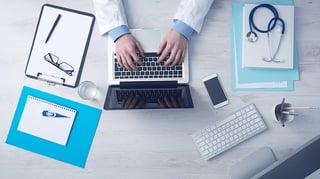 Like many industries, healthcare is poised to be revolutionized by the Internet of Things (IoT). We already have the Fitbit and similar devices that incorporate various sensors and work with smartphone apps for fitness monitoring. However, there are many more ways that the medical industry can take advantage of IoT devices, and with good end-to-end development, we can expect to see some innovative systems on the market in the next few years.
Like many industries, healthcare is poised to be revolutionized by the Internet of Things (IoT). We already have the Fitbit and similar devices that incorporate various sensors and work with smartphone apps for fitness monitoring. However, there are many more ways that the medical industry can take advantage of IoT devices, and with good end-to-end development, we can expect to see some innovative systems on the market in the next few years.
It Starts With Sensors
Wearable devices such as the Fitbit do a good job, but are fairly limited in what they can monitor. Heart rate, steps and stairs, and sleep stage are pretty much the extent of what’s available in the consumer market today. But improvements in sensor technology will enable a much wider range of applications for both the consumer and clinical markets. Examples of these expected innovations include sensors that can detect:
- Blood pressure
- Body chemistry from perspiration
- Blood chemistry, such as glucose
- Chemistry and flora in the digestive tract
- Electrocardiogram (heart) and electroencephalogram (brain) signals
In addition to sensing a wider variety of parameters, sensors will become smaller, lighter, and more flexible. You will be able to apply sensors to your skin and take no more notice of them than you would a temporary tattoo. To monitor the goings-on in your gut, you will be able to swallow a pill-sized sensor that does its work while traveling through your digestive tract. Many of these sensors will not need built-in power sources; they will be able to harvest energy from your motions or other environmental sources. They will be able to broadcast their data wirelessly to a smartphone for analysis and alerting, either on the phone itself or in the cloud.
Sensors Need Software to Make Sense
Of course, sensors are only part of the story. To create a useful system, the sensors need to be paired with good, solid software to provide you and your medical professionals with data from which diagnoses can be made, treatments can be evaluated and adjusted, and behaviors can be changed. The apps we can expect to see in the near future include:
- Monitoring of nutrients and minerals in your blood or perspiration and alerting you of imbalances that may indicate problems.
- Less-invasive monitoring of digestive tract health, from esophagus to colon, including checking for bacteria status; acid, bile, and gall content; and problems such as ulcers and cancer.
- Heart health monitoring.
- Monitoring of mental conditions such as depression and anxiety.
And many more. Developing these apps will depend on robust planning, design, and execution. This is where end-to-end development comes in.
As discussed many times in this space, end-to-end development is how AndPlus and other quality software development teams ensure software does what it’s intended to do, and does it correctly and reliably. This is especially important for any system that falls in the definition of a “medical device.” In the U.S. and many other countries, medical devices are tightly regulated; the hardware and software must be designed and tested according to rigorous quality standards and must be approved by appropriate regulatory authorities prior to sale.
End-to-end development lends itself nicely to this environment because of its emphasis on customer requirements, repeatable process, and high-quality software. Medical-device software developers need to be able to show that they followed a standard, documented process in the course of developing and testing their software, and end-to-end development is an excellent way to do it.
The Big Picture
Regulatory hurdles aside, the big picture of IoT for healthcare is its many benefits. With real-time monitoring, people will be able to take control of their health, reduce unnecessary doctor and hospital visits and lab tests, and obtain more accurate diagnoses and more appropriate treatment. The result may even be reduced healthcare costs and better-quality, more timely care for everyone.
















